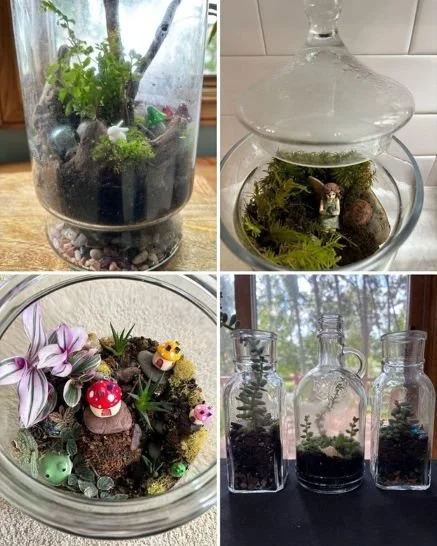Terrarium Gardening
Holly Berger, Anoka County Extension Master Gardener
When the days become shorter, colder, and darker, I try to find ways to bring my love of gardening indoors. One of my favorite winter projects is designing terrariums. These enchanting miniature gardens are fun and quite simple to make.
Typically grown in a clear, glass container, a terrarium can be closed or open and can consist of a single plant or assorted plants. For best results, choose plants with similar water and light requirements. Also, factor in the mature size of the plants when you select your container; miniature fairy garden plants are often perfectly sized for terrariums.
For closed terrariums, use plants that enjoy high humidity and lower light. Some great options include varieties of fern, pilea, peperomia, and moss. Closed terrariums can eventually become their own self-sustaining ecosystems, requiring very little watering.
With open terrariums, there are many good choices including succulents, African violets, begonias, orchids, or any plant that tolerates extra humidity. Since moisture will escape from the container, open terrariums will require more regular watering.
How to Plant a Terrarium:
Select a clean, clear container with an opening and a lid, if needed.
Fill the bottom of your container with a one-inch layer of small pebbles, if desired. Pebbles are intended to keep excess moisture away from the plants, but since they create a perched water table that could lead to root rot, some gardeners now skip this traditional step.
Spread half an inch of horticultural charcoal in your container to filter the water, prevent fungus growth, and reduce odors. Horticultural charcoal was a game changer for me. Prior to using it, my terrariums eventually become smelly and moldy, so now I won’t make a terrarium without it.
Add 2 to 4 inches of soil. Select soil based on the needs of your plants. Avoid using heavy, soggy soil.
Plan and plant. Long, narrow tools such as a terrarium tweezers, shovel and rake make placement easier.
Incorporate rocks, moss, and other elements. Layer rocks and soil to create height or to make steps.
Get creative with accessories and themes. I’m always looking for interesting rocks, seashells, and figurines to enhance my terrariums.
Terrarium Tips:
Water sparingly. Especially with closed terrariums, overwatering can lead to a sludgy disaster. A spray bottle works great to lightly mist plants, or for terrariums with small openings, a syringe is helpful.
Avoid direct sunlight, which can quickly heat up the glass and kill the plants. Most terrariums do best in bright, indirect light.
Monitor your terrarium frequently and be prepared to prune, remove or replace plants as needed. Watch for pests, dead leaves, and mold. Like all gardens, terrariums will evolve.
Shop for unique and inexpensive containers at thrift stores and garage sales. Candy dishes and cookie jars can make awesome terrariums.
Terrariums are a creative way to get your gardening fix during the cold winter months, and with the proper care, they can last for many years!
For more terrarium plant suggestions, visit:https://www.thespruce.com/great-terrarium-plants-847877

